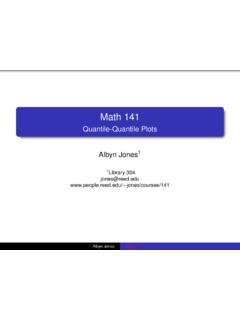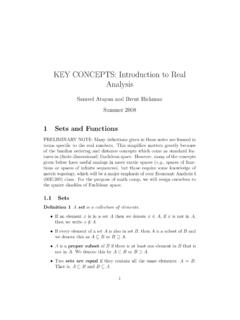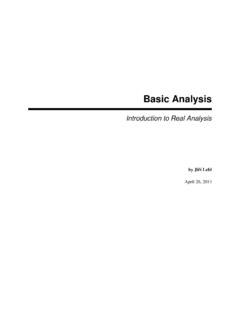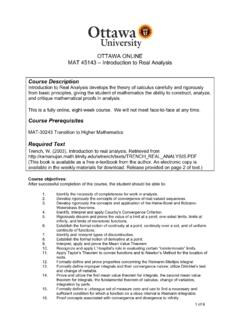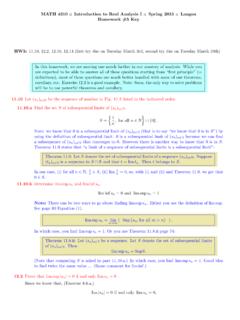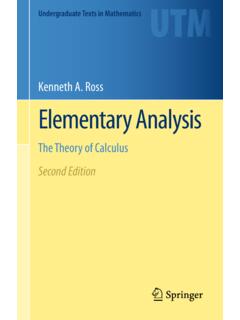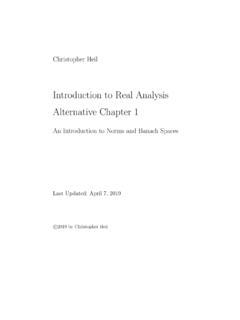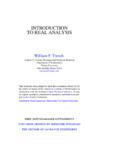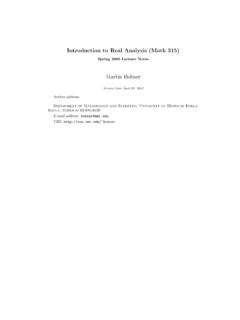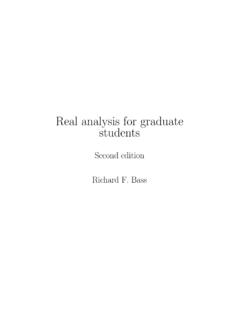Transcription of In tro duction to Analysis - Reed College
1 Intro ductiontoAnalysisIrena SwansonReed CollegeFall 2020 Table of contentsPreface7 The briefest overview, motivation, notation9 Chapter 1: How we will do mathematics13 Section : Statements and proof methods13 Section : Statements with quantifiers25 Section : More proof methods, and negation28 Section : Summation34 Section : Proofs by (mathematical) induction36 Section : Pascal s triangle45 Chapter 2: Concepts with which we will do mathematics49 Section : Sets49 Section : Cartesian product58 Section : Relations, equivalence relations59 Section : Functions65 Section : Binary operations74 Section : Fields81 Section : Order on sets, ordered fields85 Section : What are the integers and the rational numbers?
2 91 Section : Increasing and decreasing functions93 Section : The Least upper bound property ofR96 Section : Absolute values99 Chapter 3: The field of complex numbers, and topology103 Section : Complex numbers103 Section : Functions related to complex numbers106 Section : Absolute value inC108 Section : Polar coordinates111 Section : Topology on the fields of real and complex numbers1164 Section : The Heine-Borel theorem120 Chapter 4: Limits of functions123 Section : Limit of a function123 Section : When a number is not a limit134 Section : Limit theorems137 Section : Infinite limits (for real -valued functions)145 Section : Limits at infinity149 Chapter 5: Continuity151 Section : Continuous functions151 Section : Topology and the Extreme value theorem156 Section : Intermediate value theorem159 Section : Radical functions163 Section : Uniform continuity167 Chapter 6: Differentiation171 Section : Definition of derivatives171 Section : Basic properties of derivatives175 Section : The Mean value theorem183 Section : L H opital s rule188 Section : Higher-order derivatives, Taylor polynomials191 Chapter 7: Integration196 Section : Approximating areas196 Section : Computing integrals from upper and lower sums206 Section.
3 What functions are integrable?209 Section : The Fundamental theorem of calculus214 Section : Integration of complex-valued functions221 Section : Natural logarithm and the exponential functions222 Section : Applications of integration227 Chapter 8: Sequences234 Section : introduction to sequences234 Section : Convergence of infinite sequences239 Section : Divergence of infinite sequences and infinite limits246 Section : Convergence theorems via epsilon-N proofs250 Section : Convergence theorems via functions256 Section : Bounded sequences, monotone sequences, ratio test259 Section : Cauchy sequences, completeness ofR,C2635 Section : Subsequences267 Section.
4 Liminf, limsup for real -valued sequences269 Chapter 9: Infinite series and power series275 Section : Infinite series275 Section : Convergence and divergence theorems for series279 Section : Power series286 Section : Differentiation of power series291 Section : Numerical evaluations of some series294 Section : Some technical aspects of power series296 Section : Taylor series300 Section : A special function303 Section : A special function, continued305 Section : Trigonometry312 Section : Examples of L H opital s rule315 Section : Further specialized uses of trigonometry316 Appendix A: Advice on writing mathematics323 Appendix B: What you should never forget327 Index331 PrefaceThese notes were written expressly for Mathematics 112 at Reed College , with firstusage in the spring of 2013.
5 The title of the course is introduction to Analysis . Theprerequisite is calculus. Recently used textbooks have been Steven R. Lay s Analysis ,With an introduction to Proof (Prentice Hall, Inc., Englewood Cliffs, NJ, 1986, 4thedition), and Ray Mayer s in-house notes introduction to Analysis (2006, available ~ ).In Math 112, students learn to write proofs while at the same time learning about bi-nary operations, orders, fields, ordered fields, complete fields, complex numbers, sequences,and series. We also review limits, continuity, differentiation, and integration. My aim forthese notes is to constitute a self-contained book that covers the standard topics of a coursein introductory Analysis , that handles complex-valued functions, sequences, and series, thathas enough examples and exercises, that is rigorous, and is accessible to Reed College un-dergraduates.
6 I currently maintain two versions of these notes, one in which the natural,rational and real numbers are constructed and the Least upper bound theorem is provedfor the ordered field of real numbers, and one version in which the Least upper boundproperty is assumed for the ordered field of real numbers. You are currently reading theshorter, latter version. See my Math 112 ~ links to both 1 is about how we do mathematics: basic logic, proof methods, and Pascal striangle for practicing proofs. Chapter 2 introduces foundational concepts: sets, Carte-sian products, relations, functions, binary operations, fields, ordered fields, Archimedeanproperty for the set of real numbers.
7 In particular, we assume that the set of familiarreal numbers forms an ordered field with the Least upper bound property. In Chapter 3we construct the very useful field of complex numbers, and introduce topology which isindispensable for the rigorous treatment of limits. I cover topology more lightly than whatis in the written notes. Subsequent chapters cover standard material for introduction toanalysis: limits, continuity, differentiation, integration, sequences, series, ending with thedevelopment of the power series k=0xkk!, the exponential and the trigonometric func-tions. Since students have seen limits, continuity, differentiation and integration before, Igo through chapters 4 through 7 quickly.
8 I slow down for sequences and series (chapters 8and 9).An effort is made throughout to use only what had been proved. When trigonometricfunctions appear in earlier exercises they are accompanied with a careful listing of theneeded assumptions about them. For this reason, the chapters on differentiation andintegration do not have the usual palette of examples of other books. The final sections ofthe last chapter make up for it and work out much trigonometry in great detail and acknowledge and thank the support from the Dean of Faculty of Reed Collegeto fund exercise and proofreading support in the summer of 2012 for Maddie Brandt,Munyo Frey-Edwards, and Kelsey Houston-Edwards.
9 I also thank the following peoplefor their valuable feedback: Mark Angeles, Josie Baker, Marcus Bamberger, Anji Bodony,Zachary Campbell, Nick Chaiyachakorn, Safia Chettih, Laura Dallago, Andrew Erlanger,Joel Franklin, Darij Grinberg, Rohr Hautala, Palak Jain, Ya Jiang, Albyn Jones, Wil-low Kelleigh, Mason Kennedy, Christopher Keane, Michael Keppler, Ryan Kobler, OleksLushchyk, Molly Maguire, Benjamin Morrison, Samuel Olson, Kyle Ormsby, Ang elica Os-orno, Shannon Pearson, David Perkinson, Jeremy Rachels, Ezra Schwartz, Jacob Sharkan-sky, Marika Swanberg, Simon Swanson, Matyas Szabo, Ruth Valsquier, Xingyi Wang,Emerson Webb, Livia Xu, Qiaoyu Yang, Dean Young, Eric Zhang, and Jialun Zhao.
10 If youhave further comments or corrections, please send them briefest overview, motivation, notationWhat are the meanings of the following:5 + 67 98 44/5 24 81/3 = = 3 1/3 = (a b)2=a2 b2(a+b) (c+d) =ac+ad+bc+bd(a+b) (a b) =a2 b2(a+b)2=a2+ 2ab+b2 a b= ab(for whicha,b?)What is going on: 4 9 = ( 4)( 9) = 36 = 6, 4 9 = 2i 3i= 6 Youknowall of the above except possibly the complex numbers in the last two rows,where obviously something went wrong. We will not resolve this last issue until later inthe semester, but the point for now is that we do need to reason main goal of this class is to learn to reason carefully,rigorously.

